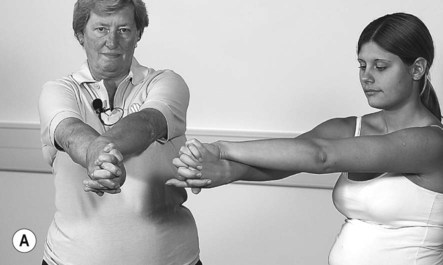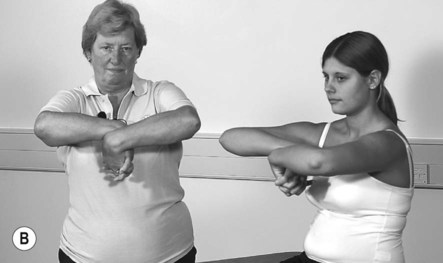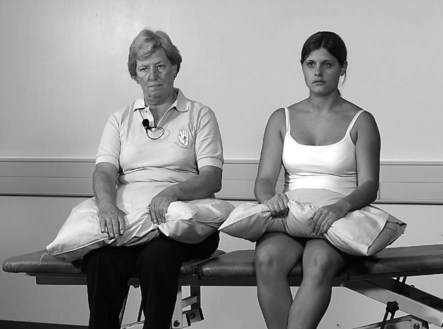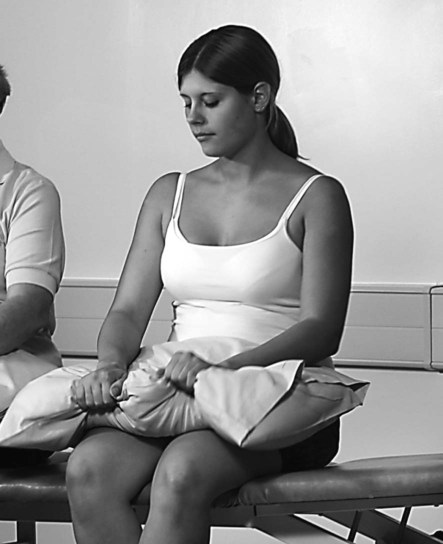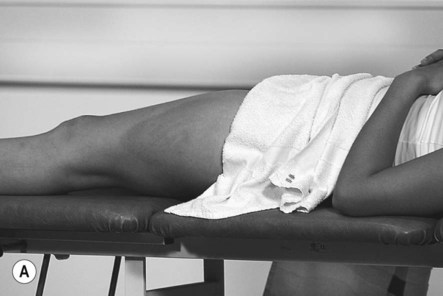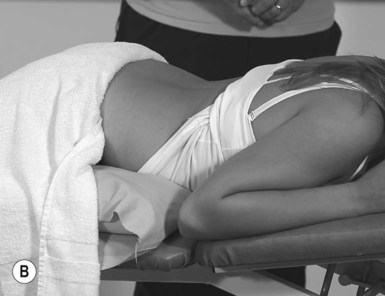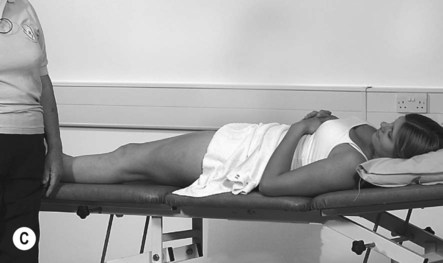Preparation encompasses the treatment room, couch, self, patient and contact medium. In the clinical setting most treatment couches/plinths can have the height adjusted to suit the individual therapist. To get a good height for performing massage, stand side-on to the couch, rest your hand with fingers loosely flexed at the metacarpal phalangeal joints and elbow not quite fully extended. Adjust height of couch until you can comfortably rest your hand as above. This takes time, trial and error to gain the optimum position (Figure 21.1). The couch should have a fresh clean cover and also a paper couch roll, pillows, a face hole or face pillow, and blanket/towels to cover the patient. It is very important to ensure that your stance allows you to reach all the parts to be massaged in a specific stroke without having to keep altering position. Stand in lunge position to perform long strokes, such as effleurage and stroking (Figure 21.2). To reach across the patient assume a similar position facing the couch (Figure 21.3). Do not stand still – let your whole body go with the stroke and always keep your pelvis tucked and knees slightly bent to protect your back. Ensure your shoulders are relaxed, comfortable and not hunched. Hands are your most important tool when using massage. They must be clean, smooth and have skin that is well nourished by using hand creams regularly. Nails should be free from polish and cut short, so they do not show above the fleshy finger pad. Only a very thin wedding ring can be worn, provided the patient does not experience any irritation from it. All other rings, bracelets, bangles and watch must be removed. It is also important to practise exercises to improve the ranges of movement of your hands. Hollis (2009) advocates full abduction/extension of the thumb to give a wide grasp of an octave span, and full flexion and extension of the wrists or at least 80 degrees of each movement, plus full pronation and supination of the radio-ulnar joints. 1. Make a fist and then spread fingers and thumbs out as far as possible; hold for 5–10 seconds. 2. Place the finger tips of one hand in contact with finger tips of other and press so that thumbs and little fingers are as widely spaced as possible. 3. Push two, three and then four fingers between two adjacent fingers of the other hand. Repeat in each space of both hands. 4. Place palms together with fingers and thumbs in contact and elbows bent at chest level. Slowly turn hands to point fingers to ground. Return to start position. 5. Place the backs of the hands together, hold arms out straight and bend elbows up towards chin to flex wrists. 6. Clasp the hands with wrists crossed and elbows straight. Bend the elbows to bring hands up to the chin and straighten the elbows out. Keep hands firmly clasped at all times. Do not force – go only as far as is possible (Figure 21.4a–c). The sense of touch and palpation skills must be highly developed in the person performing massage. It requires practice to attune and improve our sense of touch and therefore palpation skills. Start by feeling the differing textures of various types of material. Sit with a pillow on your knees and feel the pillow slip between fingers and thumb, then do the same with a towel (Figure 21.7a). Once you are happy you can easily tell one type of fabric from another repeat the exercise with your eyes closed (Figure 21.7b). Use your own body to identify anatomical landmarks and accustom your hand to the feel of differing tissues. Start by feeling the point of your elbow first with thumb tip, then each finger separately and together, and then with the palm of your hand. Repeat with each hand in turn; close your eyes and focus on the message you receive from your hands. Try the same routine on the calf, shin, anterior aspect of the thigh, forearm, neck, shoulders and abdomen. Draping or covering the patient has to be properly carried out. Use shorts, towels of various sizes, towelling robes and togas (Figure 21.8). Patient’s own clothing is also very useful. Again, explain why you want the towel tucked in and wherever possible get the patient to do this for themselves. 1. Skin infections of viral, fungal or bacterial origin are contraindications to massage. Any type of skin infection in the area to be massaged or involving the hands of the physiotherapist would preclude the application of massage. 2. Open wounds should not be massaged. Apart from being painful, massage can damage the healing tissue and restart bleeding and may cause infection. 3. Circulatory problems can be adversely affected by massage which increases blood flow and manipulates the blood vessels. Bleeding disorders, such as haemophilia, arteriosclerosis, haemorrhage, thrombosis and artificial blood vessels, are all contraindications to massage. Remember deep vein thrombosis is a total contraindication to massage. 4. Recent injury, if massaged too early in the healing process, will cause further damage. Massage at that stage will cause trauma to the fragile healing tissue leading to delay in repair, further bleeding and resultant excess scar tissue. It is recommended that massage should not be started until 48 hours after injury. Always ensure bleeding has stopped. Proceed with great care and use very gentle strokes initially. 5. Tumours can be mechanically stimulated by massage which speeds up metabolism and so spreads the tumour. Do not massage directly over or close to a tumour. Remember massage can be very effective and prove an invaluable aid to cancer victims and in palliative care. 6. Acute inflammation is contraindicated for massage as the inflammatory process can be increased by the effects produced. 7. Myositis ossificans should not be massaged directly. This can produce increased formation of bony cells and further damage the soft tissues surrounding the site. Vigorous deep massage has been known to separate small bony particles from the site of ossification. 8. Diabetes – although not a total contraindication to massage, great care must be used when treating diabetics with massage. It is usual for the peripheral circulation to be affected in diabetes and as a result blood vessels and skin can be easily damaged. Apply massage with great care. 9. Alteration of skin sensation can be a contraindication to the use of massage. There are two strokes in this group: This is, as the name suggests, a stroking movement, traditionally performed from distal to proximal in the direction of the lymph drainage (Figure 21.9a). It can also be performed in the opposite direction or in a cross over method. This manipulation can be applied using pads of fingers, thumbs, one, two or alternate hands (Figure 21.9b). A specific type of stroking is ‘Thousand Hands’, as first described by Hollis (2009). In this case, one hand is used to perform a short stroke and then the second hand performs the same movement overlapping the first. This is a fairly light touch, but must not be so light as to irritate or tickle, and can be applied in fast or slow strokes. The meaning of this word is to stroke; in massage it is a deeper form of stroking (Figure 21.10a). As such, it can be applied as described for stroking and also be reinforced with one hand over the other, or using lightly clenched fist (Figure 21.10b) or forearm. Because this manipulation goes deeper it can be graded. Grade 1 is sufficient to influence flow in superficial vessels; grade 2 affects deeper vessels; and grade 3 applies to reinforced effleurage, with one hand on top of the other. Effleurage can be applied in the direction of the lymph glands, or opposite, in all sorts of patterns from a Figure 7 or 8, to a circular or T shape.
Massage
Preparation
Couch
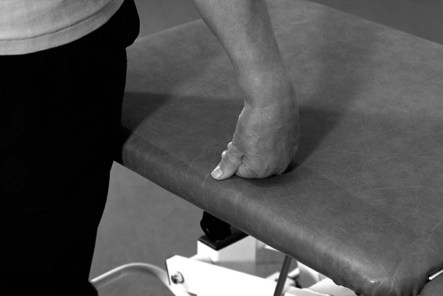
Self preparation
Stance
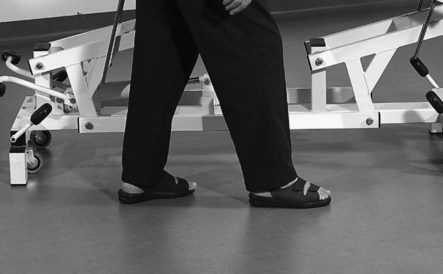
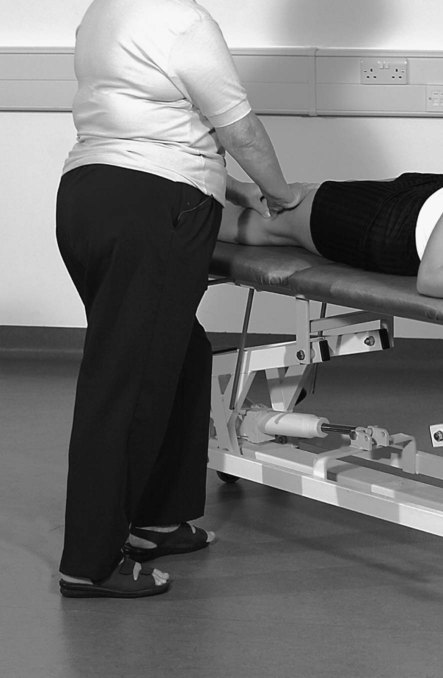
Hands
Exercises
Palpation
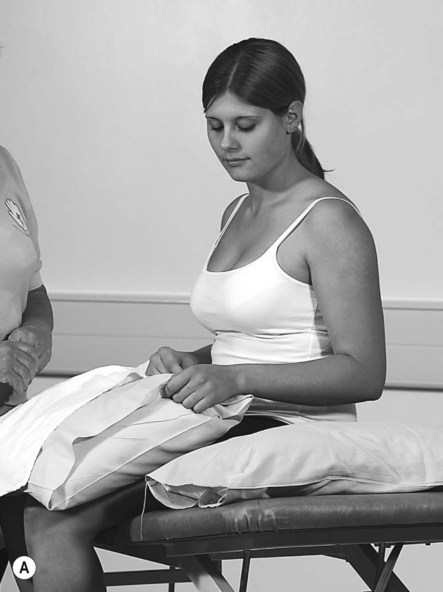

Patient preparation
Contraindications
Techniques
Stroking manipulations
Stroking
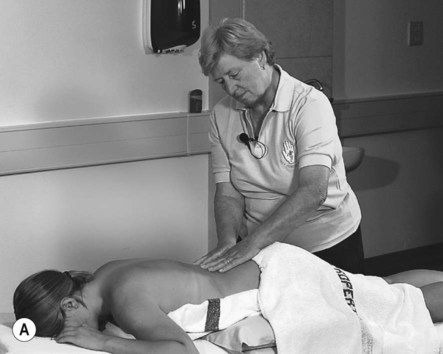
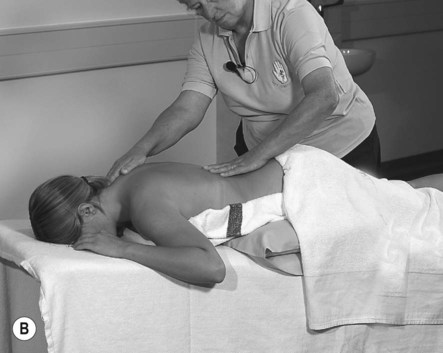
Effleurage
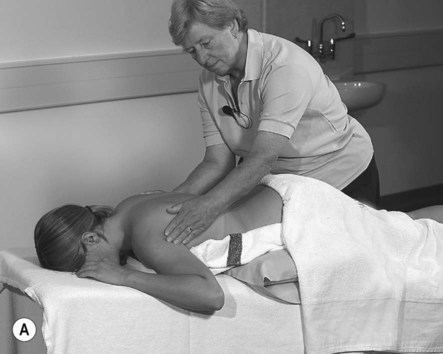
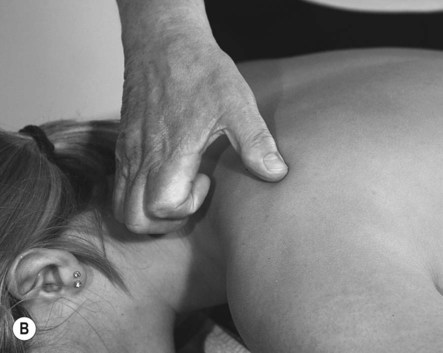
Effects of effleurage
![]()
Stay updated, free articles. Join our Telegram channel

Full access? Get Clinical Tree



